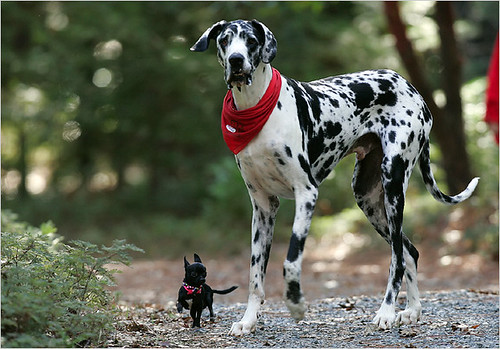One gene mutation makes all the difference in body size between a big dog and a little dog.
Image: NY Times.
There are several things that I think are amazing about dogs, Canis familiaris. First, there is a huge discrepancy in body size between different breeds -- greater than for any other mammal, in fact, and second, these vastly different dog breeds still recognize each other as being of the same species. Yet, according to a recently published research paper, this huge differential in the body size of dogs can be attributed to the effects of a single gene product. A scientific team studied 3,241 dogs from 143 breeds and discovered that small dogs share a particular mutation in one gene -- the gene that encodes insulin-like growth factor 1 (IGF1). This gene also influences size in other animal species, according to the paper's lead author, Elaine Ostrander, who is chief of cancer genetics at the National Human Genome Research Institute.
Dog breeders have unknowingly been selecting for this particular growth factor gene variant ever since they first domesticated the wolf about 15,000 years ago. In fact, since 10,000 years ago, domesticated dogs with huge size differences have been recorded. Selective breeding ensured that the altered growth factor gene was preserved and spread via human migration and trade.
"It is staggering to think that so many of the small dog breeds came about through selection on the same mutation in the same gene," said Carlos Bustamante, who is from Cornell University in Ithaca, USA and who participated in the research. "These results suggest that while there are invariably differences among breeds -- even in genes for size -- IGF1 has played an important role in the evolution of many small breeds by being a gene that consistently affects body size."
Cheek swabs for this study were collected from purebred dogs at numerous dog shows. In this study, the scientists looked at DNA from 14 small dog breeds and nine large breeds, including Portuguese water dogs, chihuahuas, fox terriers, pomeranians, Irish wolfhounds, St. Bernards and Great Danes.
"It became kind of a status symbol to participate [in the research], and we were inundated," noted Ostrander. "I only wanted one sample from any descendant of one grandfather, and owners would show up with five Scottish deerhounds, all of them siblings, and say, 'Oh, absolutely, they all want to be in.' "
The small dog breeds all shared the same mutated form of IGF1 that is found in other animals, including mice and humans. This same gene product results in smaller-than-usual mice and possibly also causes human dwarfism.
While all wolves look very much the same, modern dog breeds are found in a huge variety of shapes and sizes. Because IGF1 affects growth, it will help to further cancer research because cancers are the result of uncontrolled cellular growth. Thus, this research could deepen our understanding of cancer and other growth disorders. In future research, this gene will be manipulated in laboratory mice.
"We know this is only part of the story, but it's a necessary part of the story," said Ostrander.
This research was published recently in the top-tier research journal, Science.
Sources
A Single IGF1 Allele Is a Major Determinant of Small Size in Dogs by Nathan B. Sutter, Carlos D. Bustamante, Kevin Chase, Melissa M. Gray, Keyan Zhao, Lan Zhu, Badri Padhukasahasram, Eric Karlins, Sean Davis, Paul G. Jones, Pascale Quignon, Gary S. Johnson, Heidi G. Parker, Neale Fretwell, Dana S. Mosher, Dennis F. Lawler, Ebenezer Satyaraj, Magnus Nordborg, K. Gordon Lark, Robert K. Wayne, Elaine A. Ostrander. Science 316, 112-115 (2007). DOI: 10.1126/science.1137045.
BBC News (quotes)
NY Times (quotes)
National Public Radio streaming interview (background)


Is there anything more about the link to cancer? I can't see it (other than that the author works for a cancer institute!).
Bob
the cancer link was included in the discussion (cancer = uncontrolled cell proliferation) along with their proposed series of experiments using "knock-in" mice to further understand this relationship between IGF1 and cancer.
One cancer link, or potential link, came home to me when I was reseaching canine osteosarcoma, which has killed two of my doberman pinschers. Osteosarcoma is not uncommon in larger breeds but almost unknown in smaller breeds. Although the cause for that is not known, it has been proposed that larger breeds are more susceptible because of their rapid growth.
The phenotypic plasticity seen in domestic dogs is one of the more head-scratchingly cool things about animals that we get to see pretty regularly. Pugs and greyhounds are members of the same species? That's wild.
But the notion that knocking-in or -out any gene in a mouse is going to lead to an important breakthrough in human cancer treatment remains far fetched (in spite of the massive millions poured into the such research.)
NCI Director Klausner said in 1998, "The history of cancer research has been a history of curing cancer in the mouse. We have cured mice of cancer for decades, and it simply didn't work in humans." (LA Times Wednesday, May 6, 1998.)
And, not that anyone might give a hoot, the harm to the mice in these studies is a near certainty.
Interesting, but I'm at least as interested in the shape changes -- especially the changes in skull development that turn the basic muzzle head into the rounded form of a bulldog or pug. Then there's that whole short-legs issue.... I find myself wondering what's up with those Siberian "domestic foxes".